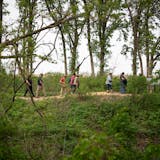Opinion editor's note: Star Tribune Opinion publishes a mix of national and local commentaries online and in print each day. To contribute, click here.
•••
Minnesotans have always been guided by values of hard work, perseverance and innovation. It is a familiar story — while past generations built this state and our nation in local mines, mills, farms and factories, many realized aspirations of economic mobility for the next generation by sending their children to college. This investment in education and Minnesota's public research university was often a ticket to the middle class and the state's economic vitality.
As the director of the U.S. National Science Foundation (NSF) and president of the University of Minnesota, we are committed to ensuring this story, emblematic of the American dream, endures. During a Twin Cities campus visit Oct. 13, we joined university leaders and U.S. Sen. Amy Klobuchar to discuss the new innovations being led by the University of Minnesota. We are working to create pathways so that the ladders of economic mobility — built on education that provides access to critical and well-paid jobs — are within reach for every community.
Ensuring the health of those pathways means investing in research and innovation. If the U.S. wants to fortify these pathways, and rest assured that our nation will continue to shape the technology transforming our world, we must act decisively.
Though a bipartisan commitment to U.S. science and engineering research, development and education has endured for decades, funding peaked in 1964. Today, by prioritizing more avenues to science, engineering and tech industries, especially because such jobs typically entail higher wages and salaries, we can support successful futures for young Americans, reinvigorate regional economies and position the nation at the cutting edge.
The University of Minnesota has been the starting point for iconic inventions and innovations, from the pacemaker to disease-resistant crops in the last century to using AI to understand climate change's effects on agriculture and developing more sustainable plastics. Today, the U is one of America's leading research universities, ranking 14th among the nation's public universities in total research expenditures, including tens of millions of competitively earned NSF funding. The U's commitment to research and sustained investments from federal agencies like NSF fuel this legacy. Meanwhile, Minnesota has 15 Fortune 500 companies and is a fertile environment for innovation. Public-private partnerships will be key to rebuilding and maintaining the excellence we all expect from U.S. science and engineering.
Beyond improving industrial efficiency, innovations spark new startups and small businesses, and the transition of more research from the lab into the real world, where discoveries improve lives. Federal initiatives like the Bipartisan Infrastructure Law are preparing Minnesota's infrastructure for next-generation advancements with necessities like rural broadband. Similarly, the landmark, bipartisan CHIPS and Science Act is revitalizing American manufacturing. More than investing in semiconductors, it calls for advances in research and development across every field to keep U.S. companies competitive and local workforces energized.
![Three weeks ago, Octavio Rodriguez switched from making transmission parts to casting parts for hospital bed brake assemblies at Twin City Die Castings. ] GLEN STUBBE • glen.stubbe@startribune.com Thursday, April 9, 2020 How employee-owned Twin City Die Casting, which just laid off 40 production workers of its 250 employees in what was supposed to be a good year, is trying to accelerate its pivot to growing medical parts business for ventilators, hospital beds, etc as it copes with instan](https://arc.stimg.co/startribunemedia/WNZYKGTZ5IYMUCO3KI5TR3N7WI.jpg?&w=80&ar=1:1&fit=crop)
djoles@startribune.com As boaters flock to Minnesota lakes and rivers this holiday weekend for the unofficial kick-off to the boating season, they'll face more inspections in and out of the water as local cities and counties ramp up their work to stop the spread of invasive species. Across the metro, more boat accesses will be staffed by watercraft inspectors thanks to $10 million funneled to county government programs this year, up from $4.5 million the state allocated last year. ORG XMIT: MIN1505222156290209 ORG XMIT: MIN1506021218440580](https://arc.stimg.co/startribunemedia/34QSKO44B2XKVNUZCO5SLJQSLY.jpg?&w=80&ar=1:1&fit=crop)

